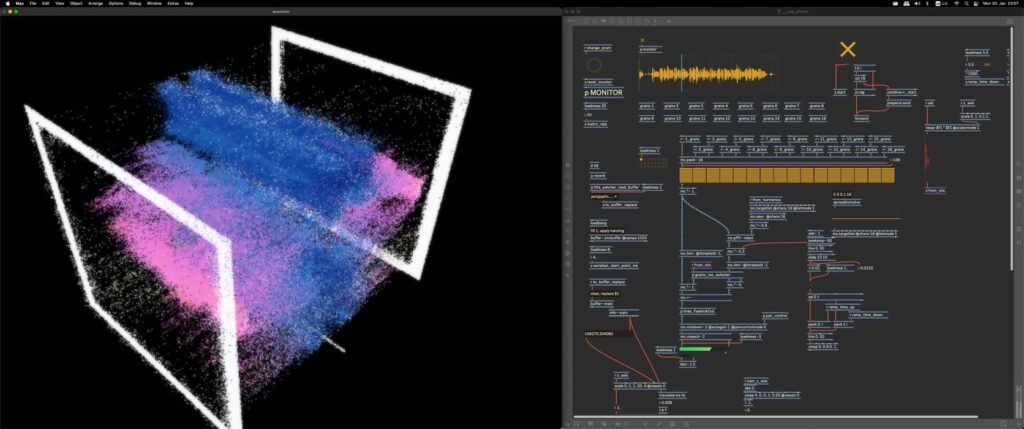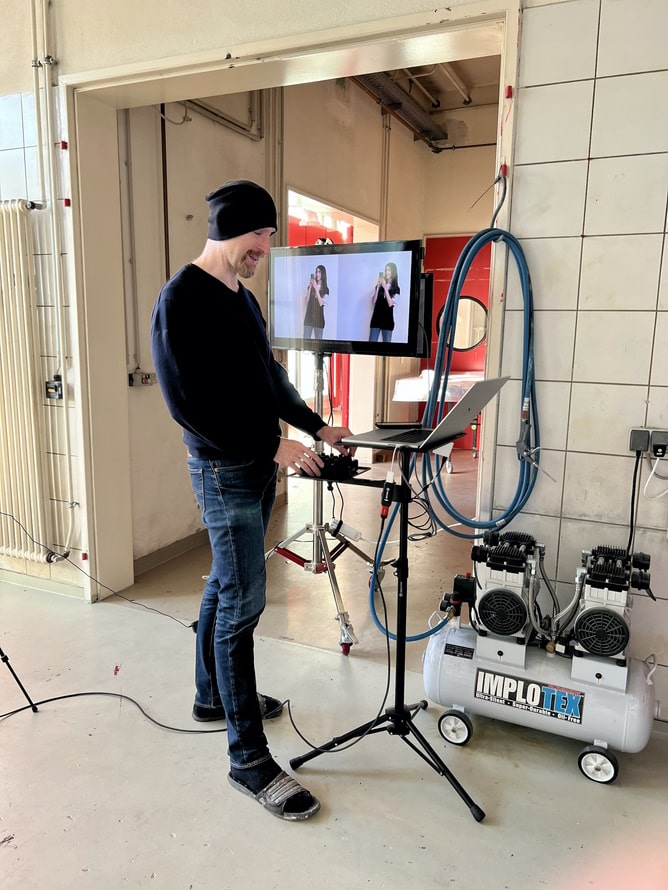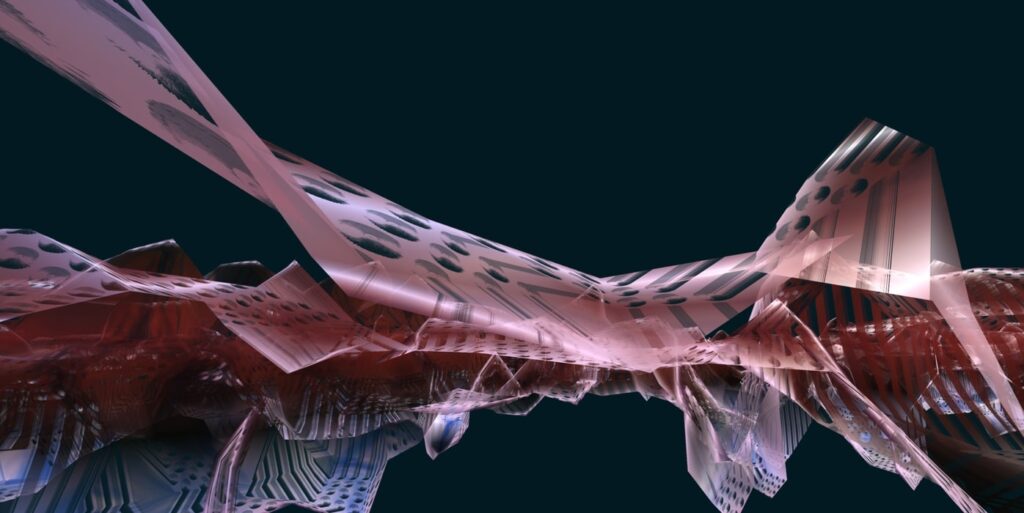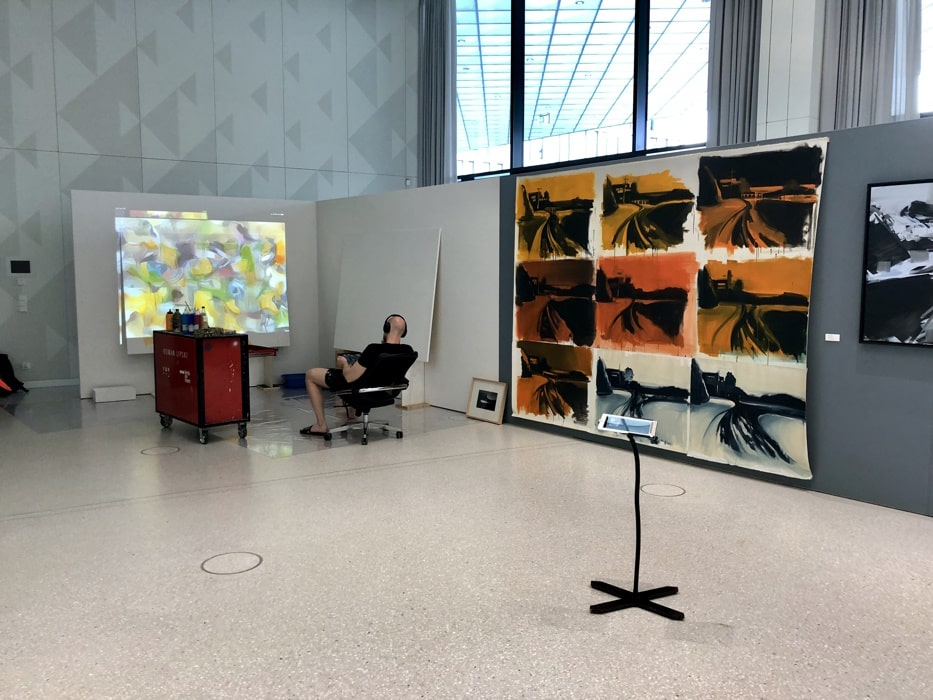The Julia Stoschek Collection will host the processual exhibition project “This Permanent Other Landscape” by artist Roman Lipski, curated by Laura López Paniagua, at the end of February 2023. In it, the artist explores the relationship between art and science by presenting the production process of his current works with technological means such as artificial intelligence (AI), virtual reality (VR) and quantum blur – an image manipulation process based on quantum calculations. In contrast to an ordinary exhibition, the rooms of the Julia Stoschek Collection will become a living studio in which the artist and his collaborators will work on site. A programme of events will accompany the project (see below). This will include an experimental lecture series entitled “This Permanent Other Landscape – Challenges of the Emerging Digital-Physical Statu Quo in Art, Science and Society” to discuss pressing questions that such technologies bring with them. The event is hosted by the Julia Stoschek Foundation independently of its official programme.
Image above: Exhibiiton view, 2018, Futurium
The use of technologies such as VR, AI and especially Quantum Blur (QB) in art is only at an early stage and thus in a phase of experimentation and discovery of their potentials, possible outcomes and consequences. The artworks that Roman Lipski is currently producing are examples of an ongoing exploration of these emerging landscapes – literally, as a landscape painter, and also metaphorically, as he enters the new realms that these technologies bring. For this reason, this exclusive four-day exhibition focuses on the complex and collective process involved in creating these works, rather than the finished works. The rooms of the Julia Stoschek Collection become a living studio where the artist and his collaborators work on site, as well as a preliminary exhibition of artworks being worked on during the show. The show is thus an “exhibition about an exhibition to come” – in an as yet undetermined future.
The exhibition is divided into three thematic rooms that show Lipski’s multi-faceted exploration of landscape painting with experimental media.
The first room, or “the studio”, is an adapted version of the artist’s studio, where he works with quantum software engineer Marcel Pfaffhauser and composer Kimin Han on his current QB project.

The second room is dedicated to Artificial Intelligence (AI), a technology with which Lipski, in collaboration with the art collective YQP and the AI company Birds on Mars in particular, jointly produced groundbreaking works between 2016 and 2021 that raise questions about the possible symbiosis of AI and humans in art production.
The third room contains the artworks that Lipski and his team produce using QB, VR and the Max/MSP sound programme. Through these transformations, a digitised 2D landscape painting is extruded through QB and becomes a new 3D landscape into which visitors can travel through VR. This visual journey is also a sonic journey, as Han is able to modulate experimental sounds according to the visual parameters of each pixel (hue, saturation, brightness and height in QBTopography). Is this the first time that landscape painting can be perceived not from an orthogonal, distant perspective, but from within in the broadest sense? Since this immersive experience clearly challenges the Greenbergian flatness of painting, could it be considered a form of virtual theatre in Fried’s sense?

The questions, difficulties and paradoxes that Lipski encounters in approaching these hybrid digital-physical landscapes are part of a broader discussion that society is having with the new technological status quo. To make this discussion public, a series of lectures and open discussions will take place with Lipski and his collaborators (scientists, quantum engineers and artists), academics and students from Berlin universities.
The title of the exhibition is a tribute to the science fiction legend Philip K. Dick, whose work often speculated on the nature of reality and its – in his opinion – multiple, overlapping worlds (or landscapes). In How to Build a Universe that Doesn’t Fall Apart Two Days Later (1978), he refers to the existence of an unchanging, ancient landscape that underlies every other world the human mind can inhabit. Could this permanent dimension be the event horizon of the current proliferation of electronic world-building?

Roman Lipski
Polish-born, Berlin-based painter Roman Lipski (born 1969 in Nowy Dwór Gdański, Poland) is a pioneer in the field of quantum art thanks to his collaboration with quantum scientists Dr James Wootton and Marcel Pfaffhauser, as well as mentoring by scientists Dr Walter Riess, Dr Mira Wolf-Bauwens and the late Stephan Schneider. His contemporary works are created using Quantum Blur, which encodes paintings into quantum states and enables their manipulation through interference patterns using quantum operations. His work with quantum technology has not only led him to reinvent his own visual language, but also to approach new subjects and experiment with different forms of representation. Currently, Lipski’s painting explores ultra-large formats and the uniquely shaped “canvases” and “worlds” (digital, 3D, textural) he develops with Quantum Blur. “There were two main motivations [for developing Quantum Blur]. One was that there weren’t many qubits to work with at the time. Whether we were using quantum hardware or simulating, we had less than 10 available. So I wanted to find a way to pack as much as possible into as few qubits as possible. That was one reason I used amplitude coding (that’s the technical term for this way of squeezing information into qubits). Another reason was that using simple quantum gates should have an interesting and ‘natural appearing’ effect, evolving the images through the wave-like nature of quantum mechanics.”
Dr. James Wootton
Lipski’s technological experiments dissect the interplay between art and science in a way that promises new forms of creativity and inspiration – a tantalising prospect. His book “Superpositions”, published by Distanz Verlag, presents this new cycle of works as well as a wide-ranging cross-section of works from the past 16 years.
Laura López Paniagua
Laura López Paniagua is a writer, curator and scholar. In 2020, she published her first monograph, Mike Kelley: Materialist Aesthetics and Memory Illusions (Mousse Publishing) and has also written for institutions such as the Venice Biennale (2019, May You Live in Interesting Times) and TATE modern (2024). She has worked at the Schinkel Pavillon and contributed to exhibitions such as Sun Rise / Sun Set (2021), HR Giger – Hans Bellmer and some of the upcoming programmes in 2023. She holds a PhD from Freie Universität and has been teaching in the Art History Department at Bard College Berlin since 2019. She is currently lecturing internationally and completing her habilitation (2024).
Kimin Han
Kimin Han studied (MA) contemporary music composition and computer music in South Korea. He developed a strong interest in acoustic phenomena, which he uses as raw material to reveal directly in his work, relying on the modern interpretation of traditional Korean music he inherited. Han has been studying media arts at the Hochschule für Gestaltung in Karlsruhe, Germany since 2019, exploring, combining and dismantling various media to realise his artistic imagination and challenge new fields such as sound visualisation and sound installation. He also continues his musical research with a focus on sound spatialisation.

Marcel Pfaffhauser
Marcel Pfaffhauser studied computer science at ETH Zurich. In 2011, he completed his Master’s degree in Theory of Computing before conducting research in quantum information theory at USI in Lugano. He then continued his education and worked as a software engineer with Unity for 5 years, focusing on augmented reality, virtual reality and gamification. In 2020, he moved to IBM Research in Zurich, where he works in the Europe Community Team on a variety of outreach activities. Some of these focus on quantum games or making quantum computing more accessible to game developers, artists and hobbyists.
Dr. James Wootton
Dr James Wootton obtained his PhD from the University of Leeds in 2010 with a thesis on topologically ordered systems and their use for quantum computing. He then worked on topological quantum error correction codes at the University of Basel until he joined the Quantum Technologies group at IBM Research – Zurich in 2018. In 2016, he set up a Citizen Science project to help the public get involved in quantum error correction research and also started using the quantum computers that IBM had just put in the cloud. This led to him joining IBM Research – Zurich in 2018. At IBM, he continues to work on quantum error correction, with a focus on using it as the basis for benchmarks for soon-to-be-released hardware. He is also investigating how quantum computing could be useful for the task of procedure generation, and is a key contributor to the Qiskit textbook.
PROGRAMME
Thursday, 23 February 2023
6:00-9:00 pm, Opening reception
Registration needed: https://forms.gle/CFTACw1mgDpCGo4J6
Friday, 24 February 2023
Experimental lecture series
This Permanent Other Landscape – Challenges of the emerging digital-physical status quo in art, science and society.
This experimental lecture series brings together the artist, his collaborators, academics from the fields of art and science, art specialists and university students to discuss pressing issues that technologies such as AI, VR and quantum computing bring.
With the kind support of Bard College Berlin and Humboldt-Universität zu Berlin.
Registration needed (limited places): https://forms.gle/fTeQUpeB5gMYnVZm9
Programme to be published shortly: https://www.romanlipski.com/current
Saturday + Sunday, 25 + 26 February 2023
noon-6:00 pm, public exhibition
Exhibition period:
Extended until Monday, 6 March 2023!
WHERE?
Julia Stoschek Collection, Leipziger Str. 60, 10117 Berlin
WHEN?
see programme above






